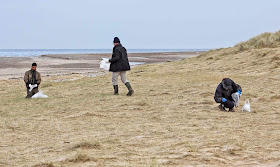For the first time ever, we have collected some DNA samples from dead pups. This involves snipping a small piece of tail flipper off. The samples will be sent of for analysis to see how the Blakeney Point Grey Seal DNA differs from Grey Seal pups in other parts of the UK and also The Netherlands, this will give an idea of how much inter-change there is of adults between breeding sites from season to season.
If you see any dead pups with green dye on them, these have been marked by us to show they have been sampled (to avoid taking a sample from the same pup twice). Although there are a few dozen pup carcasses on the Point, this is perfectly natural - a 5% mortality rate is very low.
This week, we have also been collecting seal scats for anlysis. This is basically seal poo. A student at St. Andrew's in Scotland is studying Grey Seal diet. The fish species eaten by the seal can be revealed by identifying its ear drums. This study is looking at seal diet at different sites in the UK at different times of year, to teach us more about what fish species seals are eating where and when.
Picking up a seal scat
Note how empty the beach is now, but how flat the Marram grass is
A big thank you to our volunteers who spent an afternoon helping to collect scats
At the start of this week, we will be taking down the fencelines. Now that the seals have moved on, there will be access to the beach and dunes once again. However, the very tip of Far Point will remain fenced off to protect the seals that haul out here.
With the breeding seal season over, it won't be too long before the first Sandwich Tern of spring arrives. The first one is usually spotted in Norfolk towards the end of March.
- Ajay (Coastal Ranger)
with photography by Richard Porter



No comments:
Post a Comment